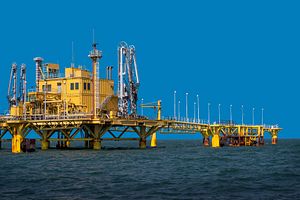Kazakhstan’s massive Kashagan oil field is scheduled to begin production again in 2017, according to Royal Dutch Shell’s 2014 annual report. The field, discovered in 2000 in the north Caspian Sea and believed to be one of the largest discovered in the past 30 years, has been troubled since its inception by delays, cost overruns, and engineering difficulties. Weeks after starting production in 2013, leaks forced it to shut down.
Earlier this year, Italian oil service company Saipem won a $1.8 billion contract to lay two 95 kilometer replacement pipelines that would enable the field to begin pumping again. The leaks that shut down production were caused by stress fractures, in turn caused by concentrations of “toxic, metal-eating hydrogen sulphide (H2S)” in the oil being pumped up 4,200 meters from under the bed of the Caspian Sea.
The new pipes, according to Saipem, will be made of carbon steel with an internal coating of a corrosion-resistant alloy. Reports last year indicated that the repairs could cost up to $3.6 billion; the Financial Times reported that several people familiar with the project would “select the more expensive, more corrosion-resistant option, putting the cost of repairs at $3.6bn or more.” It seems this prediction was off, as the $1.8 billion is at the lower range of the repair estimates.
The Kashagan project has been notorious for its cost overruns, perhaps why the consortium has opted for a lower-cost solution. The actual price tag of the whole project is in dispute. In 2012, CNN Money rated Kashagan as the world’s most expensive energy project at $116 billion. A more commonly cited number is $50 billion, which still puts the project as one of the world’s most expensive.
Eni, the Italian national oil company and one of Kashagan’s seven partners, owns a 43 percent stake in Saipem. In 2004, Saipem had a contract to lay the original pipelines for the field. Eni has a 16.8 percent stake in the consortium developing the field. Other partners include Royal Dutch Shell (16.81 percent), Total S.A. (16.81 percent), ExxonMobil (16.81 percent), KazMunayGas (16.81 percent), China National Petroleum Corporation (8.4 percent), and Inpex (7.56 percent).
In 2013, shortly before production began, Kazakhstan sold CNPC its 8.4 percent stake for $5 billion. The deal was just one of 22 agreements, amounting to $30 billion, made between Kazakhstan and China during Chinese President Xi Jinping’s state visit.
Early on in the Kashagan endeavor, in the summer of 2001, Total’s CEO Christophe de Margerie (who died in a bizarre October 2014 plane crash in Moscow), floated the idea of pumping gas from Kashagan through Iran to Europe.
“One thing that makes sense is a pipeline linking Kashagan to the border with Iran,” de Margerie told Reuters at the time.
With the possible (though not certain) lifting of sanctions against Iran on the horizon and a likely (though also not certain) date set for resumption of production at Kashagan, the energy game in Central Asia looks to be interesting for years to come.
































